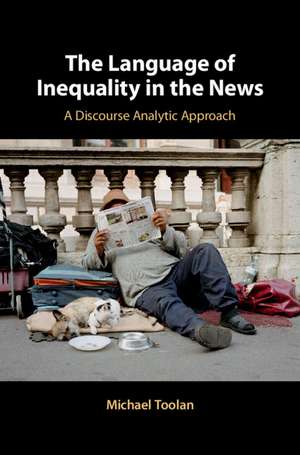The Language of Inequality in the News: A Discourse Analytic Approach
Autor Michael Toolanen Limba Engleză Hardback – 5 dec 2018
Preț: 543.08 lei
Preț vechi: 763.63 lei
-29% Nou
Puncte Express: 815
Preț estimativ în valută:
103.94€ • 108.34$ • 86.53£
103.94€ • 108.34$ • 86.53£
Carte indisponibilă temporar
Doresc să fiu notificat când acest titlu va fi disponibil:
Se trimite...
Preluare comenzi: 021 569.72.76
Specificații
ISBN-13: 9781108474337
ISBN-10: 1108474330
Pagini: 252
Dimensiuni: 156 x 235 x 17 mm
Greutate: 0.45 kg
Editura: Cambridge University Press
Colecția Cambridge University Press
Locul publicării:Cambridge, United Kingdom
ISBN-10: 1108474330
Pagini: 252
Dimensiuni: 156 x 235 x 17 mm
Greutate: 0.45 kg
Editura: Cambridge University Press
Colecția Cambridge University Press
Locul publicării:Cambridge, United Kingdom
Cuprins
Part I. Analysing the Evolving Press Discourse of Contemporary UK Inequality: 1. Increased wealth inequality in the UK; 2. Why does increasing wealth inequality matter?; 3. Facts, discourse, myths; 4. 'Ethical' differentiation; 5. Inequality as 'British' once more; 6. Why The Times and the Daily Mail?; 7. Spreading the word about the new inequality: the news media; 8. Landmarks in the politics of language tradition; 9. Language-oriented critical discourse analysis: a brief survey; 10. Corpus linguistic methods for exploring the ideology in discourse; 11. Theoretical and methodological assumptions of this study; 12. Brief outline of the chapters; 13. Political affiliations; Part II. What's Fair and Unfair in The Times: 14. The language of fairness; 15. Why concentrate on fair and unfair?; 16. The 1971 and 2011 selections of fair and unfair stories; 17. A national lottery; 18. Industrial relations in 1971: strikes and unfair dismissal; 19. Industrial relations in 2011: the burdens of employment law and 'abuse' of tribunals; 20. Mr Marples's manifesto for the control of fair incomes; 21. The squeezed middle and fair pay in 2011; 22. Fair rents, fair housing; 23. Pensions 'reform'; 24. Fair and unfair in other contexts; 25. Conclusions; Part III. Budgets and Burdens, from Barber to Osborne: 26. Introduction; 27. Style and genre differences between Barber 1971 and Osborne 2011; 28. Lexical contrasts; 29. We in Osborne; 30. Fair and help in Osborne; 31. Taxation; 32. The disappearing burden of taxation; 33. Chancellors' metaphors and the stories they tell: ruts and dust versus the march of the makers; 34. The editorial reception of the Barber and Osborne budgets in The Times and the Daily Mail; Part IV. Peter Black, Christopher Stevens, Class and Britain: 35. The TV reviewer as spokesperson of everyday ideology: Peter Black and Christopher Stevens; 36. General topics in Black and Stevens Compared; 37. Methodology; 38. Peter Black on class; 39. Class and other values in Christopher Stevens, 2013; 40. Equal and fair in CS and PB; 41. Coronation Street, sex and race, then and now; 42. Key semantic domains in Black's and Stevens's journalism: a comparative analysis; 43. The meanings of Britain and the British then (in PB) and now (in CS); 44. Conclusion; Part V. Forty-Five Years of Luddite Behaviour: 45. Ned Ludd and Robin Hood; 46. The Luddites; 47. Luddite and Luddites: grammar, meaning, and frequency; 48. Luddite in the early 1970s in The Times: a preliminary survey; 49. Luddite/Luddites used politically in The Times and the Mail during the first Thatcher term; 50. Luddite/s after June 1983; 51. The Miners' Strike of 1984-5; 52. Concluding remarks: the Luddite narrative; Part VI. Forty-Five Years of Robin Hood: 53. Powerful names; 54. Robin Hood in The Times: preliminary profile; 55. Robin Hood in the Daily Mail: preliminary profile; 56. Robin Hood in the 1970s; 57. Grunwick; 58. Robin Hood in Mrs Thatcher's 1980s and John Major's 1990s; 59. Keynes, not Robin Hood; 60. Bishops more progressive than Labour; 61. Gordon Brown as (nearly) Robin Hood: the New Labour years (1997 to 2010); 62. Robin Hood since 2010; 63. Conclusion; Part VII. Conclusion.
Recenzii
'Michael Toolan skilfully dissects the language of mainstream media, exemplified by The Times and the Mail … This book is a showcase project for all discourse-oriented interpretive social studies.' Wolfgang Teubert, University of Birmingham
Notă biografică
Descriere
Explores how UK wealth inequality is discussed in newspapers, with a particular focus on changes over the past forty-five years.
